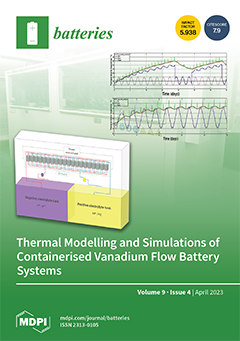Because of the unique crystal framework, bronze TiO
2 (or TiO
2(B)) is considered the prospective choice for high-performance lithium-ion battery anodes. Nevertheless, TiO
2(B) requires efficient modification, e.g., suitable doping with other elements, to improve the electronic properties and enhance
[...] Read more.
Because of the unique crystal framework, bronze TiO
2 (or TiO
2(B)) is considered the prospective choice for high-performance lithium-ion battery anodes. Nevertheless, TiO
2(B) requires efficient modification, e.g., suitable doping with other elements, to improve the electronic properties and enhance the stability upon insertion/extraction of guest ions. However, due to the metastability of TiO
2(B), doping is challenging. Herein, for the first time, TiO
2(B) co-doped with Mn, F, and N were synthesized through a successive method based on a hydrothermal technique. The prepared doped TiO
2(B) consists of ultrathin nanotubes (outer diameter of 10 nm, wall thickness of 2–3 nm) and exhibits a highly porous structure (pore volume of up to 1 cm
3 g
−1) with a large specific surface area near 200 m
2 g
−1. The incorporation of Mn, F, and N into TiO
2(B) expands its crystal lattice and modifies its electronic structure. The band gap of TiO
2(B) narrows from 3.14 to 2.18 eV upon Mn- and N-doping and electronic conductivity improves more than 40 times. Doping with fluorine improves the thermal stability of TiO
2(B) and prevents its temperature-induced transformation into anatase. It was found that the diffusivity of Li is about two times faster in doped TiO
2(B). These properties make Mn, F, and N co-doped TiO
2(B) nanotubes promising for application as high-performance anodes in advanced lithium-ion batteries. In particular, it possesses a good reversible capacity (231.5 mAh g
−1 after 100 cycles at 70 mA g
−1) and prominent rate capability (134 mAh g
−1 at 1500 mA g
−1) in the half-cell configuration. The (Mn, F, N)-doped TiO
2(B) possesses a remarkable low-temperature Li storage performance, keeping 70% of capacity at −20 °C and demonstrating potentialities to be employed in full-cell configuration with LiMn
2O
4 cathode delivering a reversible capacity of 123 and 79 mAh g
−1 at 35 and 1500 mA g
−1, respectively, at a voltage of ~2.5 V. This research underlies that regulation of electronic and crystal structure is desired to uncover capabilities of nanoparticulate TiO
2(B) for electrochemical energy storage and conversion.
Full article





